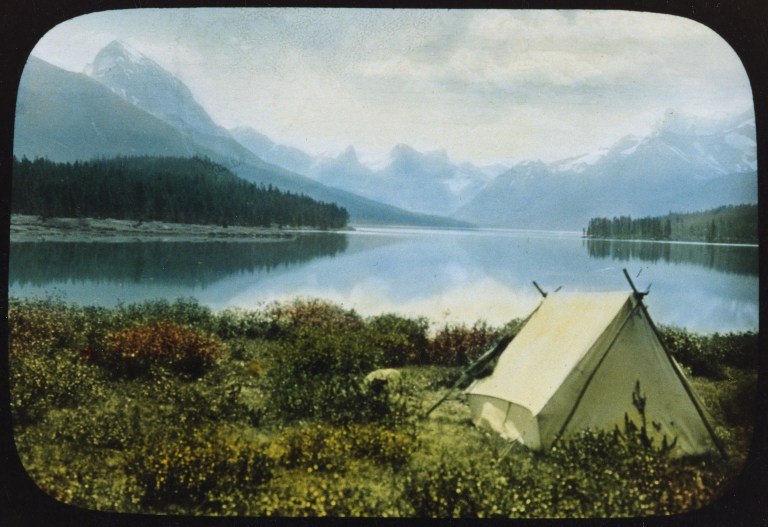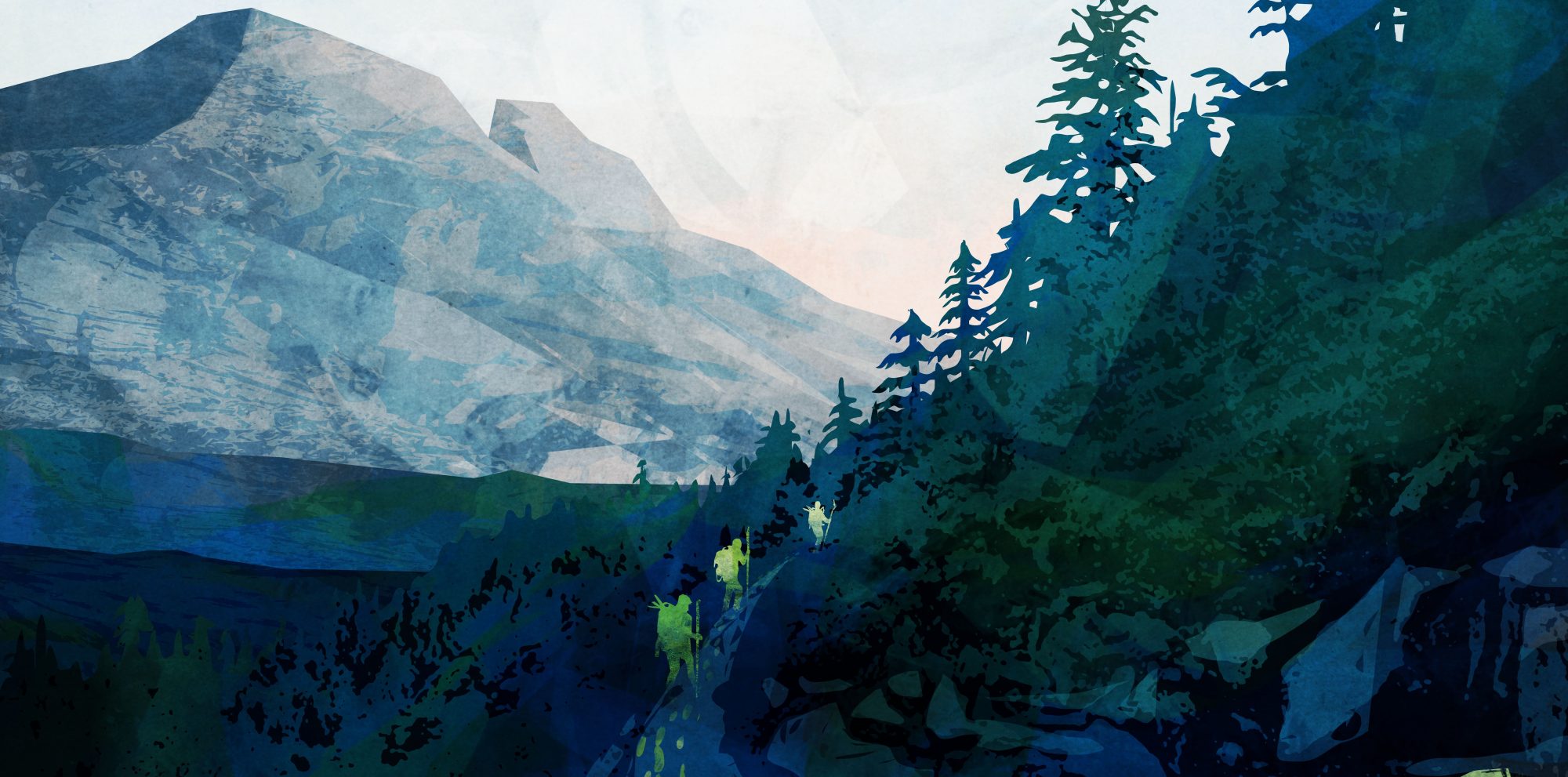Thursday, March 8th marks International Women’s Day. This year we honour the memory, achievements and spirit of Yahe–Weha (mountain woman, as she was known to the Stoney), Mary Schäffer Warren.
“Lake Louise is a pearl; Lake Maligne is a whole string of pearls.”
– Mary Schäffer Warren

The famed turquoise blue waters of Maligne Lake are bordered by impressive mountain peaks and glaciers. The lakes breathtaking natural beauty often leaves visiting tourists awestruck. But did you know that a Quaker woman from Philadelphia first surveyed, mapped and named the geological features (lake, mountains, peaks and glaciers) in the area? This remarkable pioneering woman was Mary Schäffer Warren.
Mary Townsend Sharples was born October 4, 1861 in West Chester, Pennsylvania to wealthy Quaker parents. According to all accounts, Mary lived a pampered childhood complete with servants and maids to tend to the domestic chores. This left Mary plenty of time to pursue her education and cultivate skills in the fine arts. Her parents valued such pursuits and encouraged her to follow these passions. In 1889, Mary first ventured through the Canadian Rockies by way of the newly laid Canadian Pacific Railway, on trip from Montreal to Vancouver. Little did she know that taking this trip would alter the course of her life. It was during a brief stop at Glacier House (Rogers Pass) that a young Mary was introduced to a fellow Pennsylvanian and a friend of a friend, Dr. Charles Schäffer. Although the two were separated by a 20 year age gap, they found each other to be kindred spirits and, upon their return home, the pair kept in close contact and married shortly thereafter.

Dr. Schäffer, although a practising medical doctor, loved the field of botany. In 1891, the pair decided to return to the Rocky Mountains to further document and record their botanical discoveries. Mary’s artistic abilities (drawing, painting and photography) greatly contributed to his efforts to document the flora of the alpine. Over the next decade, the couple made annual expeditions to the Rockies. In 1903, that changed. In the course of six months, Mary lost her husband, mother and father. Her fancy–free existence had come to an end: the people she had dearly loved died and their fortunes were lost (in stock market crashes or spent away foolishly). These events left an indelible mark on Mary; reflecting back on this time in her life she remarked that, “All this taught me such a bitter lesson, to count my pennies, to lean on no one and make the best of the crumbling fortunes” (1). And make the best of her situation she did. On the advice of a knowledgeable friend, Mary was able to recoup the financial losses to the point that she was set for the rest of her life. Having secured her fortunes, Mary was able to concentrate on her future. Her desire was to finish her late husband’s work. So in 1904, full of resolve, Mary returned to the Canadian Rocky Mountain backcountry to finish gathering, pressing, sketching and photographing botanical specimens. After three years of collaborative work with Stewardson Brown, curator at the Philadelphia Academy of Natural Sciences Herbarium, Alpine Flora of the Canadian Rocky Mountains was published in 1907.

With the expeditions to gather and document alpine plants completed, Mary found new reasons to continue her mountain adventures. A serendipitous encounter with the elderly Sir James Hector (a geologist on the Palliser Expedition, 1857-60) provided Mary just that; his stories fostered in her a desire to explore the uncharted and untouched Rocky Mountains. In a time where women were generally excluded from such exploits and their inclusion deemed improper, Mary continued her pursuits, not letting societal norms dictate her future endeavors. In a friendship forged with Mollie Adams, a New York geology teacher (Columbia College), Mary found the perfect travel companion. On determining whether or not exploration could be done by females, the two ladies decided:
“Why not? We can starve as well as they; the muskeg will be no softer for us than for them; the ground will be no harder to sleep upon; the waters no deeper to swim, nor the bath colder if we fall in,”—so—we planned a trip.” (1)
With that, it was decided. For several years, Mary and her friend Mollie spent their winters planning, and their summers conducting backcountry explorations in the Canadian Rockies.
During these years, Mary heard stories of a hidden lake called, Chaba Imne (Great Beaver Lake) by the Stoney. Her friend, Samson (or Sampson) Beaver (a Stoney guide) sketched a map from his memory as he had visited the lake as a child with his father. With this rough sketch in hand, Mary spent a couple of summers pursuing the lake of legend. In 1908, thanks to the determination of Mary and her crew, the lake was located. In 1911, at the age of 49, Mary was approached by the Geological Survey of Canada to survey the lake and document the area. In so doing, she named the lake, mountains, peaks and other geographic features in the area. The mountains were named for her guides (Warren and Unwin), a general advertising agent with the Grand Trunk Pacific Railway (Charlton), her childhood friend (Mary Vaux), and her nine year-old nephew that accompanied her on the survey (Paul Sharples). The peaks were named for her Stoney friends, Samson Beaver and his wife, Leah. The lake itself (Maligne Lake), she recommended be named for the river it fed into (Maligne River). In November 1911, the Geographic Board of Canada approved the names Mary submitted and Maligne Lake was included within the boundaries of Jasper National Park, thus protecting the area for future generations.

It’s worth noting that Mary’s life achievements extended beyond the realm of mountain exploration and on to writing, painting, photography, and even, world travels (Europe, Asia and Mexico). The Mary Schäffer Warren fonds, housed at the Archives and Library, Whyte Museum of the Canadian Rockies comprises a remarkable collection of personal, literary and research papers in addition to a vast array of photography (thousands of photographs, transparencies, negatives, prints, lantern slides and albums). What a testament to an extraordinary life well lived. For all your efforts and achievements, on this International Women’s Day, we salute you, Mary Schäffer Warren!
Written By: Marsha Mickalyk, Archaeological Permits & Digital Information Coordinator
Scrapbook pages courtesy of the Whyte Museum of the Canadian Rockies, from their exhibit Hobnails, Beads and Pearls. To see other women featured in their exhibit, visit their blog post: http://whytemuseum.blogspot.ca/2017/06/hobnails-beads-and-pearls-women-of.html#!/2017/06/hobnails-beads-and-pearls-women-of.html
Further Reading:
Foran, Jill. Mary Schaffer: An Adventurous Woman’s Exploits in the Canadian Rockies. Canmore: Altitude Publishing, 2003.
Karamitsanis, Aphrodite, ed. Place Names of Alberta, Volume 1: Mountains, Mountain Parks and Foothills. Calgary: University of Calgary Press and Edmonton: Alberta Culture and Multiculturalism, 1991.
Lang, Michale. An Adventurous Woman Abroad, The Selected Lantern Slides of Mary T.S. Schaffer. Calgary: Rocky Mountain Books, 2011.
Peaks & People Official Blog of the Whyte Museum of the Canadian Rockies. “Mollie Adams Diary.” Whyte Museum of the Canadian Rockies. https://whytemuseum.blogspot.ca/search/label/Mollie%20Adams%20Diary (accessed February 23, 2018).
Power, Meghan. The History of Jasper. Banff: Summerthought Publishing, 2012.
Sanford Beck, Janice. No Ordinary Woman: The Story of Mary Schaffer Warren. Calgary: Rocky Mountain Books, 2002.
Skidmore, Colleen. Searching for Mary Schäffer: Women Wilderness Photography. Edmonton: University of Alberta Press, 2017.
Mary T.S. Schäffer’s Publications:
Alpine Flora of the Canadian Rocky Mountains. Stewardson Brown, illustrated by Mrs. Charles Schäffer (Mary T.S. Schäffer), New York: G.P. Putnam’s Sons, 1907.
Among the Sources of the Saskatchewan and Athabasca Rivers. Reprinted from The Bulletin of the Geographical Society of Philadelphia, Vol. VI, No. 2, April, 1908.
(1) Old Indian Trails: Incidents of Camp and Trail Life Covering Two Years’ Exploration through the Rocky Mountains of Canada. Mary T.S. Schäffer, New York: G.P. Putnam’s Sons, 1911.
Schäffer, Mary T.S., E.J. Hart (Editor). A Hunter of Peace: Mary T.S. Schäffer’s Old Indian trails of the Canadian Rockies (with her heretofore unpublished account 1911 Expedition to Maligne Lake). Banff: The Whyte Foundation, 1980.




I’m intrigued by the cabin painting on the header of the blog. Is it somewhere local? I would love to capture it with my camera under moonlight.
Hello, the painting isn’t of any particular place, but rather a general representation of a trapper’s cabin in the foothills of Alberta. The artwork was created for a project called the Heritage Art Series, which strives to bring history to life through art. You can learn more about the trapper’s cabin piece here: https://albertashistoricplaces.wordpress.com/2014/09/18/early-cabins-in-the-west/
Thanks for your interest!